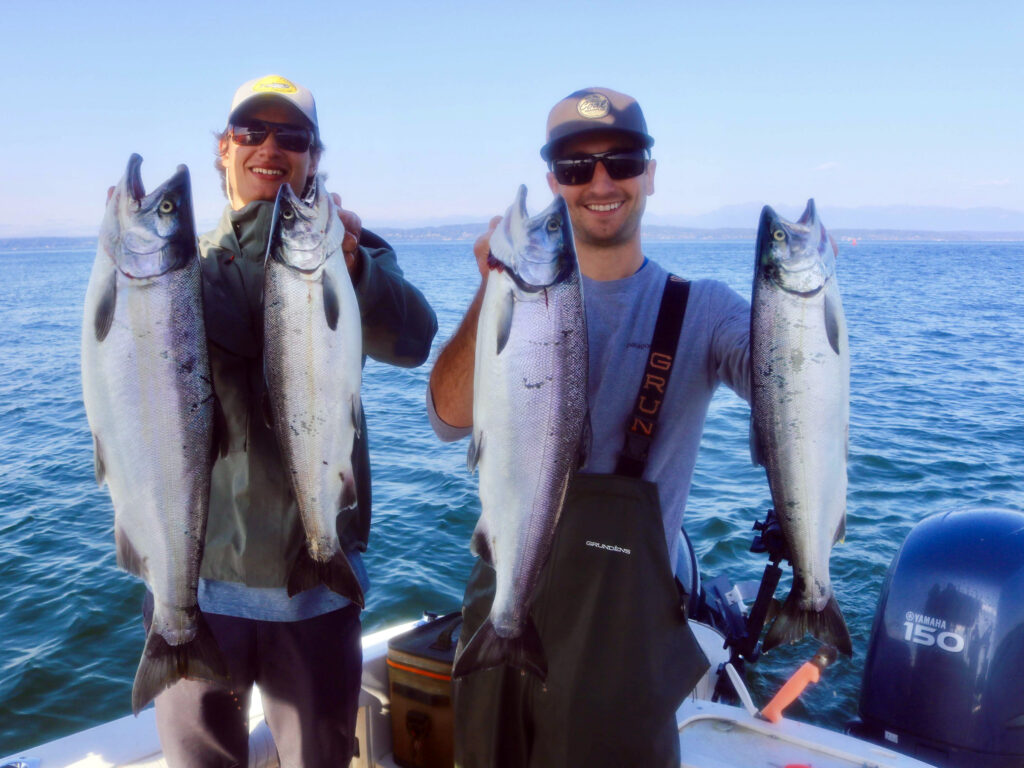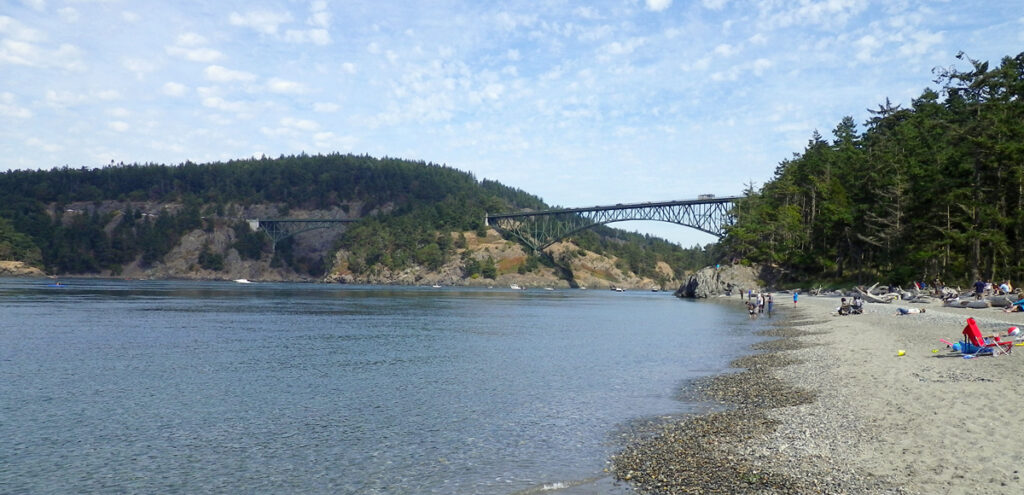The robust fishery for Coho Salmon in Washington’s Puget Sound has captured my attention for many years. As I write this, I fondly think back to my very first saltwater fishing trip. Early one September morning, I went out on a boat with a coworker and his family to fish for coho from Shilshole Bay, which is near Seattle. We launched before the first glimpse of morning light. I expected a long boat ride and rough seas. I had no idea what was in store for us. However, we drove off the breakwater at Shilshole Marina, sailed for only a quarter mile to the green can at Meadow Point, and then began fishing.
Mack didn’t have downriggers on his boat yet ample confidence that we would do well. We used a handheld flashlight to charge our glow-in-the-dark flashers and lures, and a thin slice of salted herring was put on the end of each hook. We let our Deep Six Diver setups out 22 pulls and we were fishing. Our first hookup happened within minutes. The next hour was abuzz with hooking Coho Salmon, avoiding crossed lines, netting fish, resetting gear. We boated eight Coho Salmon within an hour. We had just limited the boat. Ever since fishing that first day on Puget Sound, I have been hooked!.
Coho salmon, which are sometimes called silver salmon, are one of the most popular and rewarding types of salmon to fish for. Coho salmon are exciting to catch on both rods and reels because of their strong strikes, acrobatic jumps, and hard fighting style. This complete guide will teach you all that you need to know to catch coho salmon.
Understanding Coho Salmon
Before learning how to catch coho salmon, it’s important to understand some key facts about this fish species. Here’s a quick overview:
-
Coho salmon live in the Pacific Ocean but return to freshwater streams and rivers to spawn. They are anadromous fish.
-
They range from Alaska down to central California and are also stocked in the Great Lakes,
-
Adults commonly weigh 8-12 pounds but can reach over 30 pounds
-
Coho salmon feed on small bait fish like herring, sand lance, and anchovies while in saltwater.
-
In freshwater, they eat insects, baitfish, eggs, and other food sources.
-
They typically enter rivers from August-November and spawn shortly after.
-
They are known for their aggression when feeding and fighting.
Best Techniques for Catching Coho Salmon
There are several highly effective techniques for catching coho salmon. The best approaches include:
River Fishing
-
Casting spoons – Spoons in sizes 2-5 inches work well for enticing aggressive strikes. Copper, gold, and silver colors are top choices.
-
Twitching jigs – Mimicking injured baitfish with jigging motions triggers savage attacks. Aerojig Rabbit Twitching Jigs are excellent.
-
Float fishing – Drifting bait or lures under a float allows presenting the offering naturally with the river’s flow.
-
Plug fishing – Swimming crankbaits and stickbaits provoke instinctual strikes. The Yakima MagLip is a proven producer.
-
Fly fishing – Streamers, nymphs, egg patterns all take fish. Dead drifting offerings is effective.
Lake and Ocean Fishing
-
Trolling – Running diving plugs, spoons, hoochies, and other lures at 2-4 mph is a lethal technique. Cover water to find fish.
-
Jigging – Vertically working heavy jigs over submerged schools puts fish in the box. Oscillating the rod tip imparts action.
-
Casting lures – When salmon are in close casting the shoreline, spoons, spinners, jigs will all elicit strikes.
Prime Locations and Times
-
In rivers, target pools, flats, tailouts, and other slower holding water. Fish seams between fast and slow currents.
-
In lakes and estuaries, look for rip lines, bait, structure, and other congregation points. Fish can roam open water too.
-
In the ocean, seek out temperature breaks, upwellings, underwater ridges, etc. Salmon migrate so keep covering water.
-
Early morning and evenings are best in clear low water. Overcast and higher water sees salmon more active throughout the day.
Recommended Tackle and Gear
Having the proper tackle and gear dialed in makes a big difference when salmon fishing. Recommendations include:
-
Rods – 8-10ft, fast action rods for casting/trolling. Float/centerpin rods 11-14ft for drift fishing.
-
Reels – Spinning and baitcasters both work well. Line counter reels are preferred for trolling.
-
Line – 10-20lb test for river fishing, 20-65lb for ocean fishing depending on method. Fluorocarbon leaders.
-
Terminal tackle – Flashers, dodgers, diving disks, downriggers, divers, and weights to target desired depths.
-
Baits & lures – Spinners, spoons, plugs, jigs, baitfish, shrimp, cured roe, and worms. Always have variety!
Helpful Coho Fishing Tips
-
Stay mobile – don’t get stuck in one spot, keep covering water until you locate fish.
-
Vary retrieves – erratic approaches often out-fish smooth steady retrieves.
-
Watch the surface – boils and jumps often give away salmon locations.
-
Try different depths – coho feed from the surface down to 100+ feet deep.
-
Use scent – cures and attractant scents help get salmon to bite.
-
Fish early/late – low light periods see the most aggressive feeding activity.
Equipped with the knowledge in this guide, you now have the blueprint for successfully catching hard fighting, super aggressive coho salmon. Follow these tips and techniques and you’ll gain the edge to consistently put more of these prized game fish in the net. Just remember to check local regulations and harvest responsibly. With preparation and persistence, your next coho trip will deliver exciting action. Now get out there and hook one of the Pacific Northwest and Great Lakes premier game fish – the mighty coho salmon. Good luck!

Where To Fish for Puget Sound Coho Salmon
Puget Sound is a vast and complex environment. It has a few big underwater landmasses, like Possession Bar and Jeff Head, that get pushed up by strong tides and bring together big schools of Herring (and Coho Salmon, which also like Herring). Besides those spots, though, coho will gather anywhere the surface currents meet to make a tide rip. Even if that is in the middle of Puget Sound in the shipping lanes. For Coho, the best place to fish is at the very top of the water column, whether you’re on the bank or out in the middle.

If you want to learn more about all the places I talk about, I have a very detailed post about Chinook fishing that maps out most of these spots. Click here for a map of the Puget Sound salmon fishing hot spots.
Beach Fishing for Coho Salmon in Puget Sound
As Coho Salmon migrate back into Puget Sound, many of them travel very close to shore. This gives the beach fishing crowd a really good chance to bring home a salmon dinner. Coho Salmon are easy to catch from the shores of Puget Sound, from the northern tip of Whidbey Island to the parks along the water in the city of Seattle.
The simplest way to catch Coho from the shores of Puget Sound is with a metal jig. Use a 1 ounce to 2 ounce metal jig like a Laser Minnow or Buzz Bomb rigged with a single-point barbless hook, cast it as far as you can, and jig it back to you. Fishing with a herring under a large bobber is also a great option! If you enjoy fly fishing, you absolutely need to get to a beach to try your luck… it can be really good!

EASIEST WAY To Catch COHO Salmon (Lure Fishing)
FAQ
What is the best bait for coho salmon?
How deep to fish for coho salmon?
What is the best time of day to catch coho salmon?
Where is the best place to catch coho salmon?
How do you fish for coho salmon?
Anglers enjoy fishing for coho salmon because of their spunk. When caught, they’ll put up quite a fight. Swinging spinners work well in faster waters, while twitching jigs are preferred for calmer areas. Float fish roe, where anglers swing a cut roe with a hook attached into the water, works in both fast and slower waters.
How do you catch coho salmon in Oregon?
Off Oregon, the best coho salmon fishing is usually in ocean waters with a surface temperature of 52-56oF. That is, the temperature before the sun starts to warm the surface for the day. If you can’t find temperatures in that range, you might still catch coho. You may just work a little harder. 2. Look for the right spot to fish – Feed conditions
Can you catch coho salmon in the ocean?
For many anglers, catching coho in the open water is the best way of catching coho. There are a few options if you want to do coho salmon fishing in the ocean. Summer coho can be way out from shore. Coho tend to bunch up in tide rips, which is anywhere that the surface currents converge.
What are some tips for ocean coho fishing?
Eric Schindler, ODFW ocean salmon project leader, is a consummate ocean coho angler and offers these tips for ocean coho fishing. 1. Look for the right spot to fish – Water temperature Off Oregon, the best coho salmon fishing is usually in ocean waters with a surface temperature of 52-56oF.
